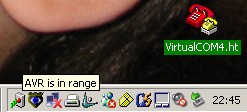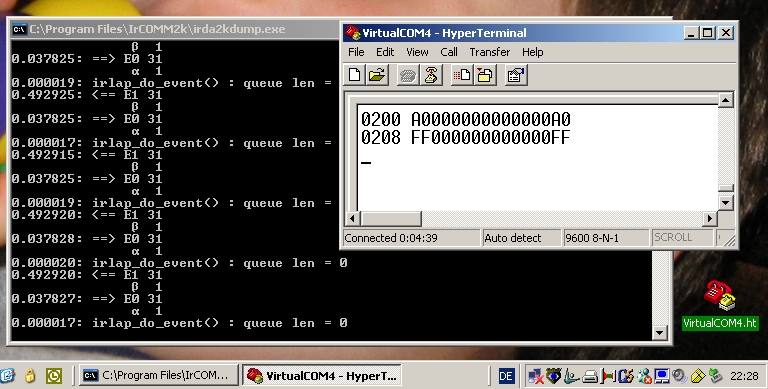IrDA® lite protocol stack for Atmel AVR microcontrollers
this Site as
pdf-file
Features:
IrDA® lite protocol fully implemented in firmware (only IR-transceiver
required)
- secondary only device
- fixed speed of 9600 bps, data size =64bytes, window size
=1, max. turn arround time 500 ms, disconnect/treshold time
of 3 seconds, additional BOFs =0
- implemented layers: physical, frame wraper, payload and
LAP , LMP , TinyTP , IrCOMM and IAS
- IrCOMM 3 and 9-Wire serial emulation
used
- one external interrupt input, one general I/O pin as output
and one 8-bit timer for timing
- ca 200 Byte of SRAM
- ca 3 kByte of Program FLASH
written in AVR Studio 4.11 (assembler)
|

|
|
|
|
The IrDA Lite was developed for simple electronic devices with small system resources. For
IrDA lite does not exist a defined specification. A Lite implementation can range
from a minimum Lite up to a complete IrDA implementation. IrDA Lite is compatible with a fully implemented
IrDA stack.
Main program (main.asm)
Initialization
- clearing of SRAM and register
- set port D that on INT0 is the input
- set timer TIMER0, enable interrupt overflow
- set and enable external interrupt at the falling edge of INT0
- UART set only for the example, otherwise it is not needed
- initialization of the IrDA subsystem
The main program loop is very simple. It is only required to check following
flags:
- timeOut might happen during IrDA communication when the connection
is lost. If it appears it is necessary to go to the IrDA subsystem handling.
Depending on the current stage, it terminates the connection or at least
goes to the stage of a disconnected mode.
- ENDTX, is set if a character sent by the IR sender is sent.
Based on that the next character of the sent frame can be sent or change
to the receive mode if all characters of the frame are sent. This all is
handled by the IrDA subsystem through calling the irtxempty procedure.
- BYTERX is set by an interrupt when the receiving of a character
is finished. It is stored in the variable RXData a moved into the IrDA subsystem
through calling the IrRxChar procedure.
- RXCOM is set if in the COM_buffer are data stored which are received
in the valid data frame. The length of received data is stored in COMCountRxData.
The user should process them now. If the user decides to send data back, the data need to put into the ir_out_buffer. In AppTxCount has to
be set the count of bytes to be sent (max 62 in one paket). It is important to
store first the data into the buffer and afterwards to set the count. A
count not equal zero in AppTxCount is the sign for the application layer
to sent these date at the next possible occasion.
- TXCOM is set when all data are successfully sent and next
data could be sent if needed.
Callback functions
The IrDA subsystem is calling a number of callback functions of the
user program.
- SendDataToCOMM - is always called when data from the IrCOM layer
is delivered which means that a data character arrives. 62 of these character
can arrive consecutively. But it is not known if these are all valid characters.
Therefore the control sum is at the end of the data frame. In the example
it is stored in the input buffer ir_in_buffer.
- DataToCOMMValid - is called in the moment when proven by the
control sum all received data are valid. The example program copies
them into the COM_buffer and advise the main program to process them. It
would be enough to only communicate that the data are valid and the main program
would find them in the ir_in_buffer. But copying them allows to process
them while already receiving new data.
- DataToCOMMError - indicates that data stored in the input buffer
are not valid, because the control sum of the frame is incorrect. In the
example nothing is copied and nothing is reported to the main program. LAP
is requesting the re-send of this data and no actions are necessary from the
user program.
- COMTxDataStart is asking if data will be sent by the application.
It is called if the primary device allows to sent data. In the example
it is checked if in the output buffer are data. If the value in AppTxCount
is unequal zero than the data transfer to the primary device is started.
- COMTxData - is asking for data to send. The user program is sending
back a character and at the same time indicating by ZF (ZERO FLAG) if more
characters are following or not. If ZF=0 (means more data) this function is
repeated (max 62 times) and all the data are sent in one data frame. If
ZF=1 it indicates that it is the last data and the sending of this fram
is finished. In the example all data stored in the ir_out_buffer are sent
consecutively.
- COMTxValid is calling when the primary device is confirming that
the data are received. In the example the flag TXCOM is set, so that the
main loop get to know that another data frame could be sent.
- COMTxError is following after sending the data frame if the primary
device doesn't confirm that the data are successful received. In the example
it is solved in a way that it shows again to the beginning and data are
re-send.
IrDA subsystem (irdavr_ls.asm)
It is not recommended that the IrDA subsystem is modified by the user. For
inquiries and questions please contact irdavr@psh-mikro.sk
Interrupts
The start bit of the serial infrared data stream triggers the external interrupt
INT0. This interrupt is disabled and the timer starts measuring the single bits.
When timer overflow it is looked for the pulse. Pulse means logic 0 and
no pulse means logic 1. After one character is received, it is moved on and
the external interrupt INT0 is enable again.
When sending the TIMER0 is used to measure the length of the single bits.
External interrupt INT0 is disabled to avoid reflections. The flag TXBYTE is
set what means that the sending is finished.
Implemented example
For an easy start an example is implemented. After PON Reset AVR sends the string "IrDA Demo V.2.04 11.04.2005"
on the serial port (115,2k @ 7, and 3, 6864 MHz, 9600 @ 2.0000 MHz).
IrDA communication
For PalmOS PDA you can use a terminal programm like "Online" from
www.marktspace.com
Select communication over infrared, 9600 Baud, 8N1N and open port. Then type
"r" and you should get back a memory dump of internal AVR memory space
0x200-0x210.
The AVR is confirming by sending back the received character over the serial
port.
The same can be tested with a Windows based PC.
In the taskbar you should be seeing

To get an IrCOMM connection you must have running a program like hyperterm
that accesses the COM emulation of IrCOMM. For virtual COMM driver for winXP
see: http://www.ircomm2k.de/

Hints about hardware
It should also be noted that the IR transceiver LED timing is completely
software controlled.
To increase the effective range of the link it is common
to calculate the current limiting resistor for the transceiver LED for pulse
operation (average current). If the AVR device leaves the LED on continually
then the IR transceiver may be permanently damaged.
Useful links:
IrDA related resources:
AVR related resources:
Palm related resources:
Windows related resources:
All logos, trademarks and brands are property of their respective owners.
last update: 22.05.2005


